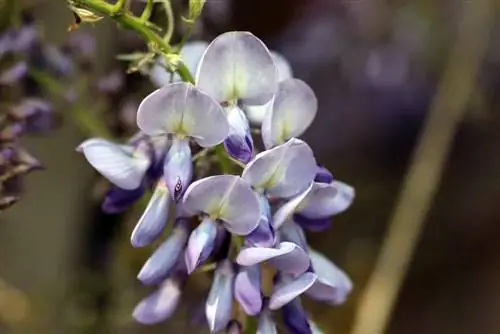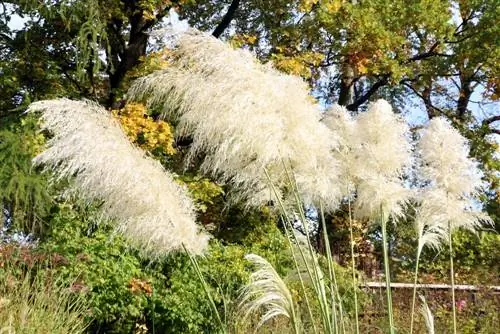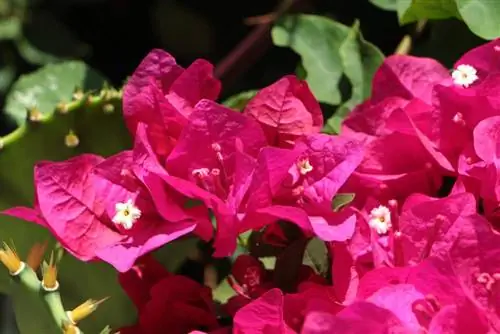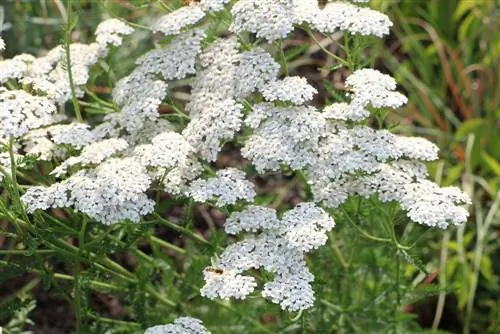- Author admin [email protected].
- Public 2023-12-17 03:39.
- Last modified 2025-01-24 12:45.
Hydreneas are popular, flowering ornamental shrubs in the garden and on the terrace, because they can be cultivated in the garden bed as well as in the pot. But what should the hobby gardener do if the hydrangeas don't want to bloom? It is usually due to the wrong location or incorrect care that the plants, which are actually quite easy to care for, do not bloom.
Thick, pink, white or blue flowers that look like balls are what characterize decorative hydrangeas. Even if some people describe the plants as old-fashioned, they are still popular in local gardens and no front garden or terrace can be imagined without them cultivated in pots. However, if the plant, which is very easy to care for, does not want to bloom, then this is usually due to the care or location of the hydrangea. If something is changed here, the plants will be in full bloom again.
Reasons
Hydrangeas are deciduous shrubs in winter. Normally, with the first warmth and the first rays of sunshine in spring, the plants show their first leaves and the flowers that have already developed in autumn also appear at this time. However, various factors of location, care and soil conditions play a major role in why the hydrangea does not bloom in spring:
- wrong location
- receive too little protection in the frosty winter
- Soil is not suitable for the hydrangea
- Plant too young
- cut too much
- other errors
Location
If the hydrangea doesn't bloom, it could be the location. This is particularly important to check in the first year. The plants prefer a partially shaded location, so a possible flaw could be that they receive too much or too little sun. Because if there is too much sunlight, the sensitive leaves and flowers of the hydrangea quickly burn. If they are too dark, they will not receive enough light to produce many flowers. If the plant was grown in a pot, it is easy to move it to a better location. This looks different with hydrangeas planted in the bed; here you should proceed as follows to improve the location:
- for hydrangeas planted under trees, check whether the tree can be trimmed to allow more light in
- Do the same thing if the hydrangeas were grown with other bushes, such as a rhododendron that has grown too large
- if too much shade is created by a house or wall, the plant should be moved to a brighter place
Tip:
The location only needs to be checked if the hydrangea doesn't bloom here in the first year. If the plant has been in this place for a long time and has always bloomed there, it cannot actually be due to the location and further reasons should be looked for.
Winter protection
Hydrangeas are only partially hardy. Therefore, if they were exposed to a very frosty and cold winter without adequate protection, they could have suffered damage. Leaves do not form until much later in a year after severe frost without adequate winter protection. However, the flower heads of the plants already form in autumn, so without appropriate protection they will simply freeze and the hydrangea will not bloom at all the next spring.

However, there are suitable measures against this:
- Put plants in the pot in a cool, protected place before the first frost
- If frost is to be expected, protect the plants in the bed with leaf mulch or brushwood on the ground
- Cover the hydrangea with plant fleece on very cold days and nights
- remove this protection on frost-free days so that the plant receives light and air
Soil texture
The wrong soil conditions can also prevent the hydrangea from blooming. If it has been cultivated near trees that are shallow-rooted, it may be that these trees are depriving the soil of the nutrients necessary for the flowering plant. Otherwise, the nutrients contained in the soil are actually sufficient in slightly acidic to alkaline soil if fertilization is carried out regularly. It should therefore be checked whether the tree next to it is shallow-rooted. You can respond accordingly with more nutrient additions for the hydrangea.
Tip:
If hydrangeas are replanted in the garden, this should not be done “from the gut”. The choice of location is very important for the flowering of the plant. If it has been cultivated in a bucket, the location can be changed again and again. She also has nutrients and substrates in the bucket all to herself.
Plant too young
If the plant has just been planted in the garden, then you cannot hope for flowers in this first year. The hydrangea has simply not yet grown in its new location and is therefore too young to produce flowers. However, if a perfect place has been found for the hydrangea and it has been lovingly cared for by the hobby gardener all year round, then it will thank you for this with lush blooms in the coming years.
Wrong cut
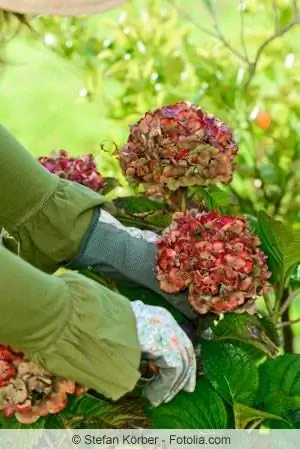
If a hydrangea is cut incorrectly, the lush flowers can fall victim to this cut. Anyone who radically cuts back their hydrangea before winter, perhaps because it has grown too big, must expect that it will not bloom next year:
- If you cut back radically in the fall, the inflorescences that have formed will also be removed
- better to only remove dead branches and dead wood
- The faded flowers can also be cut in autumn
- If the plant has become too big, it is better to thin it out from the inside than to cut it radically
- this way it can be cut back a little every autumn
- Pruning to remove old flowers and branches is better carried out in spring
- so the new flowers can be recognized more easily and do not fall victim to the scissors
Other care errors
Hydrangeas have the property of drying out quickly. For this reason, they need to be watered regularly but not excessively. Because too much water and the resulting waterlogging is just as damaging as just two days of dryness. Therefore, potted plants in particular also need to be watered in winter if they have been moved to a frost-free room. Otherwise, the flowers that had already formed in the fall may dry up over the winter. The same applies to bedding plants when the winter is very sunny and cold. However, make sure that the plant is only watered on frost-free days, otherwise winter damage could occur.
Blue flowers
If you want blue flowers on your hydrangea, you have to pay attention to a few tips, because the plant cannot produce this blue color on its own. Even commercially available blue hydrangeas will bloom pink the next year if they are given the wrong care. Therefore, for blue flowers, note the following:
- only pink hydrangeas can bear blue flowers
- It's easier with hydrangeas grown in a pot
- acidic pH value between 3.5 and 5.5 in the soil and the addition of aluminum is mandatory
- the aluminum can be added with “hydrangea blue” from the trade
- pay attention to manufacturer’s instructions when administering
- potash alum from the pharmacy can also be used
Tip:
Even if a little effort has to be made to get blue flowers, it is worth it to create a particularly beautiful colorful eye-catcher in the garden.
Conclusion
If the hydrangea doesn't want to bloom, then there are some mistakes that the hobby gardener may have made unknowingly. However, these errors can be easily fixed if the search for them is successful. The location, soil conditions, pruning and temperatures in winter must be checked so that the respective error can be labeled with certainty. Unfortunately, the inflorescences already form in autumn. For this reason, the hydrangea will not bloom profusely again until next year, no matter how early in the year the errors were identified and corrected. A second bloom cannot be expected that year.


